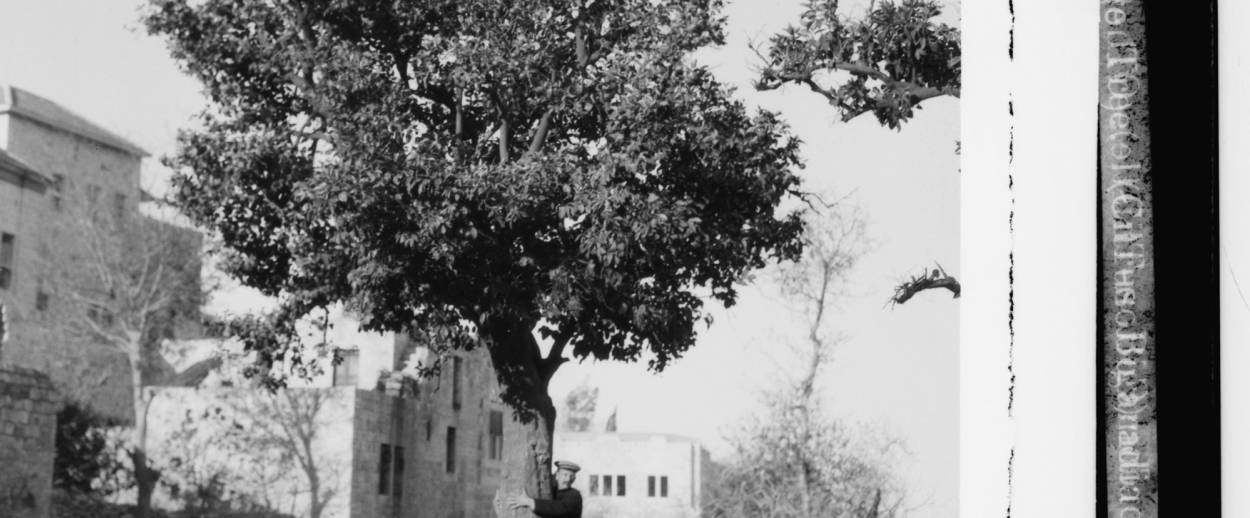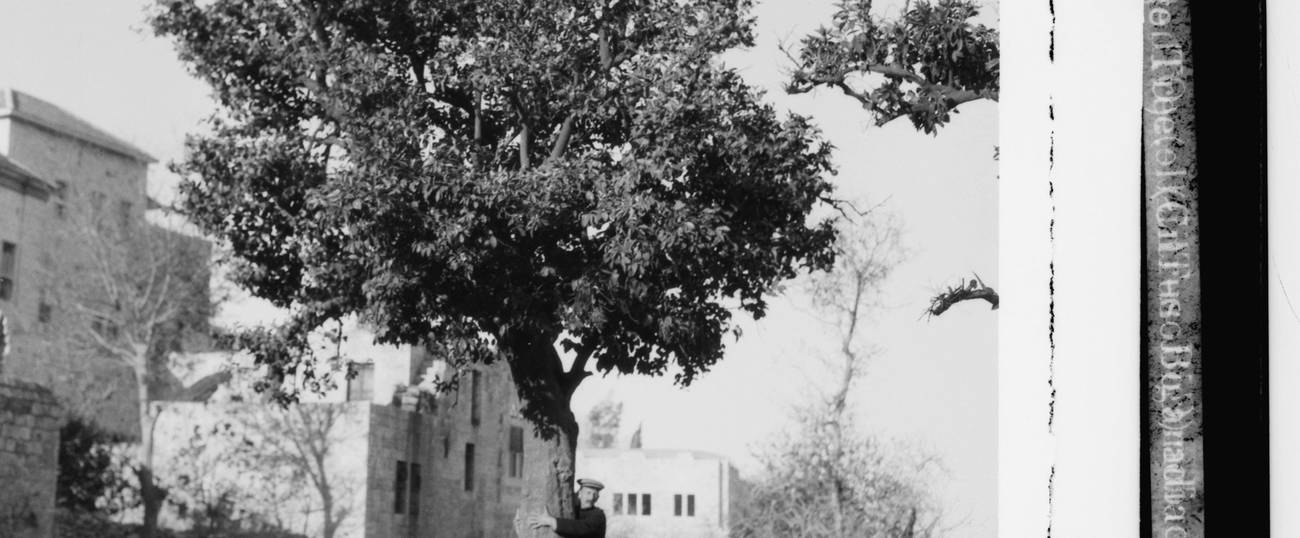S.Y. Agnon’s ‘The Etrog’: An Introduction
The 1947 short story for Sukkot appears in Tablet for the first time in English translation




And you shall take for yourselves on the first day [of Sukkot] the fruit of beautiful trees [i.e., citron = etrog], branches of palm trees [lulav], and boughs of leafy trees [myrtle = hadasim], and willows of the brook [aravot], and you shall rejoice before the Lord your God seven days.
– Leviticus 23:40
From this verse—the Biblical source for the Sukkot mitzvah colloquially referred to as “lulav and etrog”—the Talmud derives the halakhic desideratum that above and beyond obtaining proper ritual items for the performance of mitzvot, one ought to endeavor (even at additional cost) to beautify the commandments with aesthetically enhanced objects. This requirement emanates from a grammatical ambiguity in the Biblical text.
The phrase here translated as “the fruit of beautiful trees” could also be understood as “the beautiful fruit of a tree”—that is, it’s not enough to get the right species of fruit (e.g., an etrog rather than a lemon). Rather, one ought to purchase the most beautiful etrog available, often at great cost. This rabbinic inference has led generations of observant Jews toward stereotypical nitpicking in the selection of the four Sukkot species, known in halakhic parlance as hiddur mitzvah: examining each for the most minute blemish and avoiding a non-kosher or unfit item in order to obtain those most beautiful fruit.
This verse, its rabbinic derivative, and the potential tension of values derived, all serve as the plot engine for two interwoven stories by Nobel laureate S.Y. Agnon. The first tale, appearing in Tablet in a first-time English translation, was published in Ha’aretz on Sukkot eve 1947, 68 years ago today. The narrator, a fictionalized autobiographical projection of the author into his own story, sets out to purchase an etrog in the days before Sukkot in Mandate-era Jerusalem of the late 1930s and early 1940s. Among the hustle and bustle of pre-holiday Mea Shearim, the narrator learns a lesson by eavesdropping on an exchange between a certain “elderly rabbi, the rabbi of Teplik,” and the store’s aggressive “etrogger” (a delightful Agnonism: seller of etrogs). This rabbi, who becomes the story’s protagonist, was based on the real-life Shimshon Aharon Polonsky, whose righteous qualities are perfectly captured in the story—first among them his care for the many indigent Jerusalemites of the time. Polonsky, who was still alive when the story was published (he died the next year), had served for over two decades as the rabbi of Teplik (a small town in today’s central Ukraine, near the more famous Uman) prior to his aliyah in 1925, at which point he became the rabbi of Jerusalem’s Beit Yisrael neighborhood.
The rabbi resists the etrogger’s appeals not to scrimp on a technically kosher, but only minimally beautiful etrog. And here’s the moral that our narrator learns: It is not sufficient that the etrog itself be “kosher” or ritually fit for the mitzvah; the money used to purchase the etrog must itself be “kosher.” Spending to excess, when others go hungry, invalidates the etrog.
The plot spins from the tension built into the halakhah between fulfilling the need for external aesthetic and demonstrating successful absorption of the meta-halakhic values of a life of commitment to Jewish ideals. When Sukkot morning arrives, the narrator coincidentally finds himself in the presence of the rabbi, and becomes privy to the details of how he lost his etrog. So as not to spoil the story for readers, this plot turn is brought about through the story’s antagonist, “a tough, angry, irritable man” who had spent an exorbitant sum on his own etrog. It is clear that the rabbi deems this an act of arrogance and spiritual obtuseness, when no one in the neighborhood could afford such an outlandish sum on the “value added” benefit of hiddur mitzvah.
This spendthrift, irascible antagonist actually does not appear in the action of the story, but spends his time “offstage” in the Sukkah of Rebbe Shlomo of Zvhil, “to observe him as he waves the lulav, for his waving is like that of his father, who received the tradition from his father, and his father from his father back to the Maggid of Zloczow.” Rebbe Shlomo Goldman, a Hasidic Rebbe known as the Tzaddik of Zvhil who also appears in Agnon’s story, had arrived in Jerusalem in 1926 (and had died two years prior to this story’s publication), transplanting his Hasidic court to Jerusalem, where it remains today.
On Sukkot in 1948, Agnon produced this story’s prequel, entitled “That Tzaddik’s Etrog” (available in English in A Book That Was Lost). Set nearly two hundred years earlier in the impoverished home of the Maggid of Zloczow, Rebbe Yechiel Michel (1726-86; a disciple of the Ba’al Shem Tov, the founder of Hasidut) was the ancestor of our story’s Rebbe Shlomo of Zvhil. Readers of that story, which is itself a retelling of an existing Hasidic tale, transformed from a didactic legend into a more subtle and ambivalent piece of modern literature at Agnon’s hand, will see how the two stories are in dialogue with one other. The penniless Maggid, whose cupboard is bare and whose family is hungry as the holiday is about to begin, sells his tefillin for a princely sum, spending it all on the choicest of etrogs. When his famished and fretful wife discovers this she accidentally (at least in Agnon’s telling of the tale) drops the etrog, rendering it unfit for the blessing and mitzvah. On its surface the Maggid’s restrained reaction is testament to his long-suffering patience and discipline. When the listener to the tale, in the frame story through which the narrator telegraphs it to us, says, “Tell me the story again from beginning to end. This is a story worth hearing twice,” we realize that it is worth repetition, because as Agnon famously said: “Any story not worth reading twice probably wasn’t worth reading the first time.” On its retelling or re-reading, we come to understand how morally complex and compromised the Maggid is, precisely because he is held in tension between competing halakhic demands, and tragically enters the Holy Day with neither the halakhic nor meta-halakhic values intact.

But the story is also “worth hearing twice” precisely because Agnon was telling his readers that he had told it twice—set in a world nearly contemporaneous to his readers in 1947, and then thickening the matrix of his legendarium the following year by retelling the original tale on which he had drawn on the year before.
In one of the most trenchant assessment’s of Agnon’s work, Gershom Scholem wrote that Agnon’s canon is an attempt to speak to a generation which does “not accept the continuity of tradition and its language in their true context,” and therefore suggests that his readers “take them in the transformation which they have undergone in my work, take them from someone who stands at the crossroads and can see in both directions.” This twice-told tale is a model of how, reaching backward to early Hasidic folklore which itself draws on the rabbinic traditions, Agnon then narrates the story forward for his generation in Jerusalem on the eve of the establishment of the Jewish State.
The enduring power of this material, and Agnon’s success in enabling it to transcend the “crossroad,” is borne out when we consider it was precisely these two stories that Israeli filmmaker Shuli Rand was drawing on in his award-winning Ushpizin (2004), offering a third telling of the tale, this time set in an early twenty-first century setting.
Previous: S.Y. Agnon’s ‘Twofold’: An Introduction
Rabbi Jeffrey Saks is the founding director of ATID and its WebYeshiva.org program, and is the Director of Research at the Agnon House in Jerusalem. Some of his translations of Agnon’s stories have appeared in Tablet and in the Toby Press’ Agnon Library.